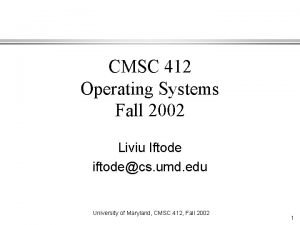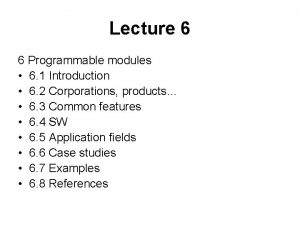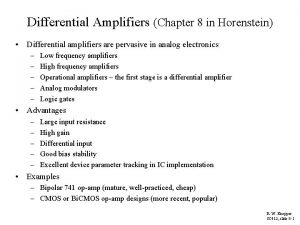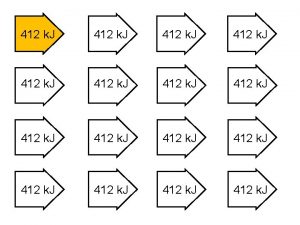CS 412 Intro to Data Mining Chapter 4













































- Slides: 45

CS 412 Intro. to Data Mining Chapter 4. Data Warehousing and On-line Analytical Processing Qi Li, Computer Science, Univ. Illinois at Urbana-Champaign, 2019 1

Chapter 4: Data Warehousing and On-line Analytical Processing q Data Warehouse: Basic Concepts q Data Warehouse Modeling: Data Cube and OLAP q Data Warehouse Implementation q Summary 2

What is a Data Warehouse? q q Support decision q Maintained Separately q Information processing q “A data warehouse is a subject-oriented, integrated, time-variant, and nonvolatile collection of data in support of management’s decision-making process. ”—W. H. Inmon q Data warehousing: q 3 Defined in many different ways, but not rigorously The process of constructing and using data warehouses

Data Warehouse—Subject-Oriented q 4 Help make decisions q A simple and concise view (modeling and analysis) q Not details (transaction processing) q Organizing around major subjects, such as customer, product, sales q Excluding data that are not useful in the decision support process

Data Warehouse—Integrated q q q 5 Integrating Multiple, heterogeneous sources Ex. relational databases, flat files, on-line transaction records Consistency q Data cleaning and data integration techniques are applied. q Ex. Hotel price: differences on currency, tax, breakfast covered, and parking q When data is moved to the warehouse, it is converted

Data Warehouse—Time Variant Data Warehouse Operational Database Long time horizon (e. g. , past 5 -10 years) current value data Contains an element of time, explicitly or data may or may not contain “time implicitly element” 6

Data Warehouse—Nonvolatile q Independence – A physically separate store q Static – No data management (updates, transaction processing, recovery, and concurrency control mechanisms) q Requires only two operations in data accessing: q 7 initial loading of data and access of data

Why a Separate Data Warehouse? Different functions and different data: q missing data: Decision support requires historical data which operational DBs do not typically maintain q data consolidation: DS requires consolidation (aggregation, summarization) of data from heterogeneous sources q data quality: different sources typically use inconsistent data representations, codes and formats which have to be reconciled q Note: There are more and more systems which perform OLAP (online analytical processing) analysis directly on relational databases q 8

OLTP vs. OLAP q OLTP: Online transactional processing q DBMS operations q Query and transactional processing q OLAP: Online analytical processing 9 q Data warehouse operations q Drilling, slicing, dicing, etc.

Data Warehouse: A Multi-Tiered Architecture q Top Tier: Front-End Tools q Middle Tier: OLAP Server q Bottom Tier: Data Warehouse Server q 10 Data

Three Data Warehouse Models q Enterprise warehouse - Specially designed for the entire organization q Data Mart q Specific, selected groups q Independent vs. dependent (directly from warehouse) data mart q 11 Virtual warehouse q A set of views over operational databases q Only some of the possible summary views may be materialized https: //www. guru 99. com/data-warehouse-vs-data-mart. html

Extraction, Transformation, and Loading (ETL) q q q q q 12 Data extraction get data from multiple, heterogeneous, and external sources Data cleaning detect errors in the data and rectify them when possible Data transformation convert data from legacy or host format to warehouse format Load sort, summarize, consolidate, compute views, check integrity, and build indicies and partitions Refresh propagate the updates from the data sources to the warehouse

Metadata Repository Meta data is data about data. It stores: q Description of structure (schema, etc. ) q Operational meta-data q data lineage (history of migrated data and transformation path), currency of data (active, archived, or purged), monitoring information (warehouse usage statistics, error reports, audit trails) q The algorithms used for summarization q The mapping from operational environment to the data warehouse q Data related to system performance q warehouse schema, view and derived data definitions q Business data q business terms and definitions, ownership of data, charging policies q 13

Chapter 4: Data Warehousing and On-line Analytical Processing q Data Warehouse: Basic Concepts q Data Warehouse Modeling: Data Cube and OLAP q Data Warehouse Implementation q Summary 14

From Tables and Spreadsheets to Data Cubes q A data warehouse is based on a multidimensional data model which views data in the form of a data cube q Main function is to provide summarizations of the data q q 15 E. g. , summarize the units or dollars sold at a particular store over a particular time period Can compute summarizations online (as they are requested) Can be very slow Better to precalculate some summarizations

Design of Data Warehouses 16 q Dimension tables, such as item (item_name, brand, type), or time(day, week, month, quarter, year) q Fact table contains measures (such as dollars_sold) and keys to each of the related dimension tables q Different schema exist q Star q Snowflake q Fact constellation

Data Cube: A Lattice of Cuboids all time 0 -D (apex) cuboid item time, location time, item location item, location time, supplier location, supplier item, supplier time, location, supplier time, item, location time, item, supplier 1 -D cuboids 2 -D cuboids 3 -D cuboids item, location, supplier 4 -D (base) cuboid time, item, location, supplier 17

Data Cube: A Lattice of Cuboids all Example: Suppose we don’t care about the supplier. This 3 -D cuboid gives a summarization over all suppliers. time, item time 0 -D (apex) cuboid item time, location item, location time, supplier location, supplier item, supplier time, location, supplier time, item, location time, item, supplier 1 -D cuboids 2 -D cuboids 3 -D cuboids item, location, supplier 4 -D (base) cuboid time, item, location, supplier 18

Data Cube: A Lattice of Cuboids Total sales, regardless of time, item, location, or supplier. all Example: Suppose we don’t care about the supplier. This 3 -D cuboid gives a summarization over all suppliers. time, item time, location item, location time, supplier time, item, supplier 1 -D cuboids location, supplier item, supplier time, location, supplier time, item, location 0 -D (apex) cuboid 2 -D cuboids 3 -D cuboids item, location, supplier 4 -D (base) cuboid time, item, location, supplier 19

Calculating Number of Cuboids q Consider dimensions as binary numbers q Example: 4 dimensions q Each is either in the cuboid, or not in the cuboid q ( , , , ) choice of 0 or 1 for each element of vector q Sum up for each position: 23 + 22 + 21 + 20 + 1 (0 -d cuboid) = 24 q 20 In general, 2 d cuboids (d = number of dimensions)

Conceptual Modeling of Data Warehouses q 21 Modeling data warehouses: dimensions & measures q Star schema q Snowflake schema q Fact constellations

Star Schema: An Example A fact table in the middle connected to a set of dimension tables time item time_key day_of_the_week month quarter year Sales Fact Table time_key item_key branch_key branch_name branch_type location_key units_sold dollars_sold avg_sales Measures 22 item_key item_name brand type supplier_type location_key street city state_or_province country

Snowflake Schema: An Example A refinement of star schema where some time dimensional hierarchy time_key day is normalized into a day_of_the_week month set of smaller quarter dimension tables, year forming a shape similar to branch snowflake branch_key branch_name branch_type item Sales Fact Table time_key item_key branch_key location_key units_sold dollars_sold avg_sales Measures 23 item_key item_name brand type supplier_key supplier_type location_key street city_key city state_or_province country

Fact Constellation: An Example time_key Multiple fact tables day_of_the_week share dimension tables, month viewed as a collection quarter year of stars, therefore called galaxy schema or fact constellation item Sales Fact Table time_key item_key location_key branch_name branch_type units_sold dollars_sold avg_sales Measures time_key item_key shipper_key from_location branch_key branch 24 item_key item_name brand type supplier_type Shipping Fact Table location to_location_key street city province_or_state country dollars_cost units_shipped shipper_key shipper_name location_key shipper_type

A Concept Hierarchy for a Dimension (location) all Europe region country city office 25 Germany Frankfurt . . Spain North_America Canada Vancouver. . . L. Chan . . . Mexico Toronto M. Wind

Multidimensional Data q Sales volume as a function of product, month, and region Re gi on Dimensions: Product, Location, Time Hierarchical summarization paths Industry Region Product Category Country Quarter Product City Office Month 26 Year Month Day Week

Pr od TV PC VCR sum 1 Qtr 2 Qtr Date 3 Qtr 4 Qtr sum Total annual sales of TVs in U. S. A Canada Mexico sum 27 Country uc t A Sample Data Cube

Product 4 Qtr 3 Qtr U. S. Ca A nad Me a xic o Cub a 2 Qtr 1 Qtr Date Country 28 28

Cuboids Corresponding to the Cube all 0 -D (apex) cuboid product, date country product, country 1 -D cuboids date, country 2 -D cuboids product, date, country How can we play with the Cube? 29 3 -D (base) cuboid

Roll up & Drill down Roll up (drill-up): summarize data by climbing up hierarchy or by dimension reduction Roll up Drill down 30 Phone PC Watch earphone Product(types) Drill down (roll down): reverse of roll-up from higher level summary to lower level summary or detailed data, or introducing new dimensions

Q 1 Q 2 Q 3 Q 4 Phone PC Watch earphone Product(types) Dice for (Location = "Toronto" or "Vancouver") and (Time = "Q 2" or "Q 1") and (Product = "Phone" or "PC") 31 Vancouver Time Chicago New York Toronto Vancouver Slice for (Location = "Vancouver") Toronto Vancouver Time Lo ca tio ns Dice and Slice Q 2 Q 1 Phone PC Product(types)

Other Typical OLAP Operations q q q 32 Pivot (rotate): reorient the cube, visualization, 3 D to series of 2 D planes Drill across: involving (across) more than one fact table Drill through: through the bottom level of the cube to its back-end relational tables (using SQL)

Data Cube Measures: Three Categories q Distributive: if the result derived by applying the function to n aggregate values is the same as that derived by applying the function on all the data without partitioning q q q Algebraic: if it can be computed by an algebraic function with M arguments (where M is a bounded integer), each of which is obtained by applying a distributive aggregate function q avg(x) = sum(x) / count(x) q How about standard_deviation() Holistic: if there is no constant bound on the storage size needed to describe a subaggregate. q 33 E. g. , count(), sum(), min(), max() E. g. , median(), mode(), rank()

Browsing a Data Cube Visualization q OLAP capabilities q Interactive manipulation q 34

Chapter 4: Data Warehousing and On-line Analytical Processing q Data Warehouse: Basic Concepts q Data Warehouse Modeling: Data Cube and OLAP q Data Warehouse Implementation q Summary 35

Efficient Data Cube Computation q If I have n dimensions, each with Li levels, how many cuboids are needed to preprocess all? q Calculating all cuboids is costly in computation and time. q How to decide which cuboid be pre-calculated (Materialization)? q q q Based on size of data, sharing, access frequency, etc. Example: I know my users always search by Quarter, so that cuboid should be pre-calculated. Example: If I pre-calculate days, I can use days as input to Months (30 or 31 days), or weeks (7 days), etc. Why this formula? Sector Location Industry Region Category Country Quarter Product City Office 36 Time Year Month Day Week

The “Compute Cube” Operator Cube definition and computation in DMQL(Data Mining Query Language) define cube sales [item, city, year]: sum (sales_in_dollars) compute cube sales q Transform it into a SQL-like language (with a new operator cube by, introduced by Gray et al. ’ 96) () SELECT item, city, year, SUM (amount) FROM SALES (city) (item) (year) CUBE BY item, city, year q Need compute the following Group-Bys (2 ^ 3) (city, item) (city, year) (item, year) 3 D Cuboid (date, product, customer), 2 D Cuboid (date, product), (date, customer), (product, customer), 1 D Cuboid (date), (product), (customer) (city, item, year) 0 D (Apex) Cuboid () q 37

Indexing OLAP Data Indexing q Main purpose of indexing is to make the calculation faster/efficient q Common Warehouse Index: Bitmap Index q Benefits in Warehousing: q Reduced response time for large classes of ad hoc queries. q Reduced storage requirements compared to other indexing techniques. q Dramatic performance gains even on hardware with a relatively small number of CPUs or a small amount of memory. q https: //docs. oracle. com/database/121/DWHSG/schemas. htm#DWHSG 9041 38

Indexing OLAP Data: Bitmap Index on a particular column q Each value in the column has a bit vector: bit-op is fast q The length of the bit vector: # of records in the base table q The i-th bit is set if the i-th row of the base table has the value for the indexed column q Not suitable for high cardinality domains. (WHY? ) q A recent bit compression technique, Word-Aligned Hybrid (WAH), makes it work for high cardinality domain as well [Wu, et al. TODS’ 06] Base table Index on Region Index on Type q 39

Efficient Processing OLAP Queries Determine which operations should be performed on the available cuboids q q Transform drill, roll, etc. into corresponding SQL and/or OLAP operations, e. g. , dice = selection + projection Determine which materialized cuboid(s) should be selected for OLAP op. q q Let the query to be processed be on {brand, province_or_state} with the condition “year = 2004”, and there are 4 materialized cuboids available: 1) {year, item_name, city} 2) {year, brand, country} 3) {year, brand, province_or_state} 4) {item_name, province_or_state} where year = 2004 Which should be selected to process the query? 40

OLAP Server Architectures Relational OLAP (ROLAP) q Data is stored in a relational database. q Greater scalability q Multidimensional OLAP (MOLAP) q Everything is in multi-dimensional storage (see page 26 for an example) q Fast indexing to pre-computed summarized data q Hybrid OLAP (HOLAP) q Used by : Microsoft SQLServer q Combines both ROLAP & MOLAP q Theoretically provides best performance q 41

Chapter 4: Data Warehousing and On-line Analytical Processing q Data Warehouse: Basic Concepts q Data Warehouse Modeling: Data Cube and OLAP q Data Warehouse Implementation q Summary 42

Summary Data warehousing: A multi-dimensional model of a data warehouse q A data cube consists of dimensions & measures q Star schema, snowflake schema, fact constellations q OLAP operations: drilling, rolling, slicing, dicing and pivoting q Data Warehouse Architecture, Design, and Usage q Multi-tiered architecture q Business analysis design framework q Information processing, analytical processing, data mining q Implementation: Efficient computation of data cubes q Partial vs. full vs. no materialization q Indexing OALP data: Bitmap index and join index q OLAP query processing q OLAP servers: ROLAP, MOLAP, HOLAP q 43

References (I) q q q A. Gupta and I. S. Mumick. Materialized Views: Techniques, Implementations, and Applications. MIT Press, 1999 q J. Han. Towards on-line analytical mining in large databases. SIGMOD Record, 1998 q V. Harinarayan, A. Rajaraman, and J. D. Ullman. Implementing data cubes efficiently. SIGMOD’ 96 q 44 S. Agarwal, R. Agrawal, P. M. Deshpande, A. Gupta, J. F. Naughton, R. Ramakrishnan, and S. Sarawagi. On the computation of multidimensional aggregates. VLDB’ 96 D. Agrawal, A. E. Abbadi, A. Singh, and T. Yurek. Efficient view maintenance in data warehouses. SIGMOD’ 97 R. Agrawal, A. Gupta, and S. Sarawagi. Modeling multidimensional databases. ICDE’ 97 S. Chaudhuri and U. Dayal. An overview of data warehousing and OLAP technology. ACM SIGMOD Record, 26: 65 -74, 1997 J. Gray, et al. Data cube: A relational aggregation operator generalizing group-by, cross -tab and sub-totals. Data Mining and Knowledge Discovery, 1: 29 -54, 1997.

References (II) q q q q 45 C. Imhoff, N. Galemmo, and J. G. Geiger. Mastering Data Warehouse Design: Relational and Dimensional Techniques. John Wiley, 2003 W. H. Inmon. Building the Data Warehouse. John Wiley, 1996 R. Kimball and M. Ross. The Data Warehouse Toolkit: The Complete Guide to Dimensional Modeling. 2 ed. John Wiley, 2002 P. O'Neil and D. Quass. Improved query performance with variant indexes. SIGMOD'97 S. Sarawagi and M. Stonebraker. Efficient organization of large multidimensional arrays. ICDE'94 P. Valduriez. Join indices. ACM Trans. Database Systems, 12: 218 -246, 1987. J. Widom. Research problems in data warehousing. CIKM’ 95. K. Wu, E. Otoo, and A. Shoshani, Optimal Bitmap Indices with Efficient Compression, ACM Trans. on Database Systems (TODS), 31(1), 2006, pp. 1 -38.
 Complex data types in data mining
Complex data types in data mining Mining complex data types
Mining complex data types Mining multimedia databases
Mining multimedia databases Strip mining vs open pit mining
Strip mining vs open pit mining Strip mining before and after
Strip mining before and after Difference between strip mining and open pit mining
Difference between strip mining and open pit mining Difference between text mining and web mining
Difference between text mining and web mining Data reduction in data mining
Data reduction in data mining Data mining in data warehouse
Data mining in data warehouse What is missing data in data mining
What is missing data in data mining Data reduction in data mining
Data reduction in data mining Data reduction in data mining
Data reduction in data mining Data reduction in data mining
Data reduction in data mining Shell cube in data mining
Shell cube in data mining Data reduction in data mining
Data reduction in data mining Data warehouse dan data mining
Data warehouse dan data mining Perbedaan data warehouse dan data mining
Perbedaan data warehouse dan data mining Crm data warehouse models
Crm data warehouse models Multidimensional analysis and descriptive mining of complex
Multidimensional analysis and descriptive mining of complex Olap data mining
Olap data mining Noisy data in data mining
Noisy data in data mining Data warehouse architecture types
Data warehouse architecture types Markku roiha
Markku roiha Data compression in data mining
Data compression in data mining Introduction to data warehouse
Introduction to data warehouse Data warehouse dan data mining
Data warehouse dan data mining The preterite of hacer and dar (p. 412)
The preterite of hacer and dar (p. 412) Maria buchert
Maria buchert Resolucion 412 de 2000
Resolucion 412 de 2000 Kj 412 not angka
Kj 412 not angka Cmsc 412
Cmsc 412 Ist 412
Ist 412 Ertugrul 412
Ertugrul 412 Duygu çelik ertuğrul
Duygu çelik ertuğrul Martin jagersand
Martin jagersand Cse 412
Cse 412 412 nutrition
412 nutrition Easy 412-ac-rc
Easy 412-ac-rc Phonak supero 412
Phonak supero 412 P-fet short 412
P-fet short 412 Ertugrul 412
Ertugrul 412 Friday 412
Friday 412 Ekyros com
Ekyros com 5 cfr 412
5 cfr 412 Shoreline school district 412
Shoreline school district 412 Factors of 412
Factors of 412


































































